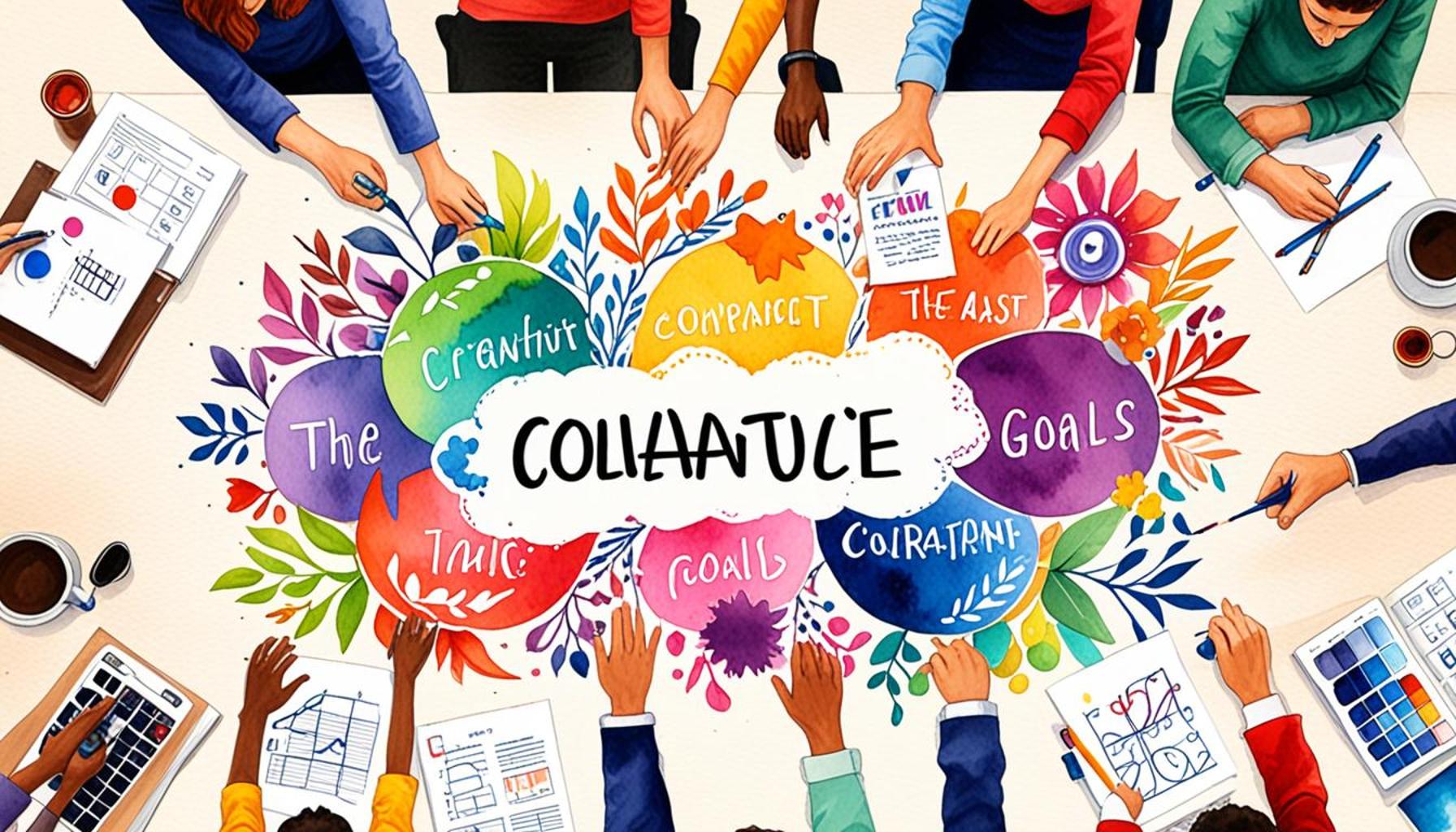The Impact of Collaborative Goals on the Development of a Growth Culture in Teams

Cultivating a Culture of Collaboration
In a work landscape marked by constant change and complexity, the ability to achieve goals is heavily reliant on the synergy generated through teamwork. Collaborative goals are not just statements of intent; they serve as the bedrock for establishing trust among team members, fostering motivation, and nurturing a collective sense of purpose. Essential for cultivating a culture rich in growth and continuous improvement, collaborative goals allow organizations to thrive amid the diverse challenges they face.
Recognizing the key elements of collaborative goals can significantly elevate a team’s effectiveness and productivity:
- Alignment: This ensures that all team members understand and work toward common objectives, effectively harmonizing their contributions and efforts. For instance, in a marketing team of a Nigerian tech startup, alignment might mean everyone understands the target audience and marketing strategy, resulting in consistent branding across all channels.
- Shared Accountability: When team members hold each other accountable, it cultivates a sense of ownership. This might manifest in regular check-ins or shared project management tools that allow everyone to track progress and celebrate milestones together, fostering a positive feedback environment.
- Increased Engagement: Engaging all individuals on a deeper level often leads to enhanced creativity and innovation. For instance, brainstorming sessions that incorporate different perspectives can lead to unique solutions for complex challenges, tapping into the diverse backgrounds of team members.
In Nigeria, a country marked by rich cultural diversity and a dynamic workforce, the implementation of collaborative goals can be particularly transformative. Organizations that promote shared objectives benefit in several ways:
- They create an inclusive environment where every voice matters, drawing on the unique insights of each member, regardless of their background.
- They respect Nigeria’s cultural values, which emphasize community and cooperation, thereby enhancing team cohesion and loyalty.
- Utilizing the collective knowledge of diverse team members enables organizations to tackle complex problems more effectively, leading to innovative solutions that drive performance and productivity.
Exploring the impact of collaborative goals reveals the intricate mechanisms behind successful teamwork. By aligning objectives through clear communication and fostering a sense of belonging, organizations not only enhance their team dynamics but also cultivate a sustainable growth culture. In Nigeria’s rapidly evolving business landscape, understanding and implementing collaborative goals can serve as a critical factor in transforming how teams operate and succeed together.
RECOMMENDED: Check out this similar article

The Mechanisms Behind Collaborative Goals
The implementation of collaborative goals within teams is often straightforward, yet the implications are profound. Fundamentally, these goals act as a conduit for *enhancing communication*, *improving collaboration*, and ultimately achieving *greater results*. The journey towards fostering a growth culture in teams begins with understanding how these elements interact to shape team dynamics and productivity.
At the heart of successful collaborative goal-setting lies the principle of effective communication. This is not merely about sharing information; it is about creating a shared language that resonates with each team member. In Nigeria’s vibrant work environments, where linguistic and cultural diversity flourish, establishing a clear communication framework is essential. For instance, when a team adopts inclusive language that reflects various dialects and cultural references, it promotes understanding and reduces barriers. This sense of inclusion can significantly transform team morale, as evidenced by organizations that have embraced this approach, often seeing tangible spikes in creativity and engagement.
Furthermore, the nature of alignment in a team’s objectives cannot be overstated. When team members rally around a common goal, their individual contributions gain context and purpose. This alignment is particularly crucial in sectors like technology and education, where diverse skills and expertise intersect. For instance, a team tasked with developing an educational app might include developers, designers, and educators. By identifying a shared goal—such as enhancing accessibility for users with disabilities—the team can channel their efforts towards a productive outcome, resulting in a solution that embodies innovation and inclusivity.
The infusion of shared accountability further enhances the collective endeavor. As team members commit to support one another in achieving collaborative objectives, they create a fabric of mutual respect and trust. This model of accountability manifests through mechanisms such as regular progress meetings and the use of collaborative tools like Trello or Asana. In Nigeria, where teamwork is often influenced by communal values, fostering this shared responsibility can amplify a sense of belonging and loyalty, leading the team to exceed its individual and collective potentials.
Moreover, the impact of collaborative goals extends beyond immediate team interactions; they permeate the larger organizational culture. An organization that prioritizes collaboration cultivates a growth mindset, encouraging ongoing learning and adaptation. This is particularly important in a competitive market like Nigeria, where adaptability can make the difference between thriving and merely surviving. Businesses that encourage training programs and feedback loops focused on collaborative successes demonstrate a commitment to nurturing their workforce, thus enabling them to face challenges with resilience and creativity.
- Enhanced Communication: Establishing clear and inclusive communication frameworks that resonate with diverse team members.
- Shared Goals: Aligning objectives that provide clear context and purpose to individual contributions.
- Mutual Accountability: Promoting a culture of responsibility where team members support one another in achieving common goals.
- Growth Mindset: Encouraging ongoing learning and adaptability through collaborative practices.
As organizations in Nigeria strive to build robust and resilient teams, understanding the mechanics of collaborative goals is crucial. The integration of these elements not only transforms individual contributions but also nurtures an organization-wide culture of growth, setting the stage for sustained success in an ever-evolving marketplace.
The dynamic between collaborative goals and a growth culture within teams is multifaceted and essential for driving organizational success. When teams establish clear, collaborative objectives, members are more likely to engage in open communication, share insights, and pool their diverse skills to overcome challenges. This engagement not only boosts morale but also fosters an environment conducive to innovation.
Furthermore, teams that operate under a framework of shared goals often exhibit heightened accountability. Each member understands their role in achieving the collective objective, which can lead to improved performance and productivity. This sense of ownership is a crucial component in a culture that emphasizes continuous improvement and learning.
Data indicates that organizations that implement collaborative goal-setting can see a significant increase in employee engagement, decreasing turnover rates and enhancing overall job satisfaction. This statistical correlation suggests that when team objectives align with personal growth aspirations, individuals are more likely to remain in their roles and contribute positively.
For instance, teams that actively engage in setting SMART goals—specific, measurable, achievable, relevant, and time-bound—are more likely to achieve their desired outcomes. The process of collaboratively defining these goals encourages participation at all levels, empowering team members and enhancing their commitment to the team’s objectives.
Moreover, fostering a growth-oriented culture through collaborative goals allows for constructive feedback and a willingness to embrace challenges. When team members view setbacks as opportunities for learning rather than failures, a resilient mindset develops. This adaptability is crucial in today’s ever-evolving business landscape, where agility and responsiveness are essential for success.
As teams continue to navigate an increasingly complex work environment, the integration of collaborative goals into their operational framework stands out as a powerful tool. By embracing this approach, organizations can cultivate a culture that not only champions growth but also propels teams toward greater achievement and fulfillment.
| Advantage | Impact |
|---|---|
| Enhanced Team Collaboration | Fosters trust and open communication among team members. |
| Increased Accountability | Encourages ownership and responsibility towards shared objectives. |
| Boosted Employee Engagement | Leads to lower turnover rates and improved job satisfaction. |
| Constructive Feedback Culture | Encourages learning from mistakes rather than fear of failure. |
Understanding these advantages positions teams to leverage collaborative goals effectively, spearheading a transformative movement within their organizational culture.
YOU MAY ALSO LIKE: Read read another article
The Ripple Effect of Collaborative Goals on Team Dynamics
The influence of collaborative goals goes well beyond the immediate boundaries of team interactions; it creates a ripple effect that transforms team dynamics and enhances the organizational culture. By fostering an environment where individuals work towards shared objectives, teams cultivate a climate of trust and psychological safety that encourages risk-taking and innovation. This transformation is particularly essential in the Nigerian workplace, where a blend of competition and collaboration can often dictate the level of success a team achieves.
Inclusion plays a critical role in this transformation. When teams leverage diverse perspectives to set collaborative goals, they invite creativity and innovation. For example, a Nigerian startup focused on renewable energy may employ individuals from various academic backgrounds—engineering, environmental science, and business. Collaborative goal-setting can enable them to create a unified agenda that not only addresses energy challenges but also fosters environmentally friendly practices. This inclusive approach not only aids in comprehensive problem-solving but also ensures that all voices are heard, contributing to a sense of ownership among team members.
Moreover, the promotion of a learning culture is inherent to the process of pursuing collaborative goals. In Nigeria’s rapidly evolving market, teams must remain agile and open to new ideas. To facilitate this, organizations should integrate learning opportunities directly into the goal-setting process. Implementing workshops and training sessions related to ongoing project objectives can serve as catalysts for team development. When individuals see their growth directly linked to collaborative efforts, they are more inclined to invest time and energy into these initiatives. For instance, a bank implementing a new digital service can encourage cross-departmental training to ensure all employees understand their roles in achieving the goal. This not only enhances operational efficiency but also nurtures professional growth among team members.
A tangible benefit of fostering a growth culture through collaborative goals is the enhancement of team resilience. In the face of challenges—be it market fluctuations, technological advancements, or any unforeseen events—teams that share common objectives tend to become more adaptable. Each setback transforms into a learning opportunity, contributing to a culture that celebrates resilience. This adaptability is crucial in Nigeria, where businesses must navigate complex market landscapes. An instance could be a tech company that faces regulatory changes; through shared goals, the team can efficiently pivot and innovate, thus maintaining performance amidst adversity.
Furthermore, the role of leadership cannot be understated in this context. Leaders who embody and promote collaborative goal-setting practices cultivate an atmosphere where continuous improvement is not just encouraged—it is expected. By actively participating in goal formulation and supporting team members in reaching these goals, leaders not only amplify their influence but also contribute to a culture that prioritizes growth. For instance, during a departmental goal-setting meeting, a manager who solicits feedback from employees not only fosters inclusivity but also illustrates the importance of each team member’s input.
- Inclusion: Leveraging diverse perspectives to foster creativity and comprehensive problem-solving among team members.
- Learning Culture: Integrating professional development opportunities into collaborative goal-set initiatives to promote continuous growth.
- Team Resilience: Building adaptability and a positive response to challenges through shared objectives and joint learning experiences.
- Leadership Engagement: Encouraging participation and feedback in goal-setting processes to strengthen team cohesion.
As teams in Nigeria embark on the journey of collaboration, the understanding and execution of these dynamics become pivotal. Each individual’s contribution matters, and through collective goals, everyone is empowered to participate in shaping a growth-oriented culture that will define the future of the organization.
CHECK OUT: Click here to explore more
Conclusion: Shaping a Growth Culture Through Collaborative Goals
In conclusion, the impact of collaborative goals on the development of a growth culture within teams is profound and multifaceted. As explored, the integration of diverse perspectives fosters innovation, while the cultivation of a learning culture empowers team members to continually develop their skills and adapt to changing environments. In the context of Nigeria’s vibrant and challenging market landscape, the ability to create shared objectives not only enhances team performance but also strengthens resilience in the face of adversity.
Team success hinges on the participation of all members, where each individual’s contributions lead to a sense of ownership and accountability. Moreover, the role of strong leadership in promoting collaborative goal-setting cannot be understated. Leaders who actively engage their teams in formulating goals pave the way for greater inclusivity and align the team’s direction with organizational values.
As businesses in Nigeria and beyond strive for competitive advantage, embracing collaborative goals can be a transformative strategy. Organizations that prioritize these objectives not only see improvements in team dynamics but also cultivate a robust growth culture that anticipates change and celebrates resilience. Moving forward, the continuous exploration and implementation of collaborative practices can empower teams to navigate challenges effectively, innovate boldly, and ultimately thrive in a fast-paced world.



